![]() The space shuttle was a type of space vehicle with vertical takeoff, capable of leaving the Earth's atmosphere and being reusable, unlike conventional rockets. It can carry astronauts and satellites, supporting a maximum load of 29.5 tons. At launch, it consisted of 2 booster rockets and a main engine, being discarded during the period that the shuttle remains in orbit (8.5 minutes). Its construction was carried out after the Apollo program and was designed to reach a space station and supply it. His conditions allowed him to go and return comfortably, and after a week he would be ready for another launch.
The space shuttle was a type of space vehicle with vertical takeoff, capable of leaving the Earth's atmosphere and being reusable, unlike conventional rockets. It can carry astronauts and satellites, supporting a maximum load of 29.5 tons. At launch, it consisted of 2 booster rockets and a main engine, being discarded during the period that the shuttle remains in orbit (8.5 minutes). Its construction was carried out after the Apollo program and was designed to reach a space station and supply it. His conditions allowed him to go and return comfortably, and after a week he would be ready for another launch.
The first to be put into orbit and return under its own power was Columbia, on April 12, 1981, returning to Earth two days later. Before any launch, the vehicle was completely checked for its tiles, gear wheels, brakes, windows, etc. The lower tiles, for example, had to withstand re-entry into the atmosphere at around 2,500° C.
 The speed reached by the gigantic vehicle reached 38,400 km/h, necessary to escape the Earth's gravity without problems, implying an approximate expense of 100 million dollars each time the vehicle left Earth.
The speed reached by the gigantic vehicle reached 38,400 km/h, necessary to escape the Earth's gravity without problems, implying an approximate expense of 100 million dollars each time the vehicle left Earth.
The shuttle turned out to be enormously useful in spacewalks, launching communications satellites and the Hubble space telescope into orbit; This vehicle was retired between March and July 2011, with the STS-135 mission being the last of its kind, launched on July 8, 2011 and returning on July 21 of the same year.
Tragedies aboard the Space Shuttle
In the entire history of the Space Shuttle, only one tragedy with fatalities had been recorded. This was suffered by the Challenger on January 28, 1986, when a failure in one of its booster rockets produced a total explosion of the device 73 seconds after being launched, killing its 7 astronauts and causing the temporary suspension of the launch program.

However, on February 1, 2003, a new misfortune struck the astronautical environment: Columbia, the first of its kind to fly into space, disintegrated during its re-entry to Earth due to a break in the thermal coating of its wing. right at the time of takeoff, a month earlier from Cape Kennedy. As a result, its 8 occupants perished, including the first Israeli astronaut to fly into space.
This event forced the suspension of all shuttle space flights until the causes of the disaster were identified. This event, added to the need to promote a new generation of spacecraft with more sophisticated and safe systems, would motivate the retirement of the space shuttles.


